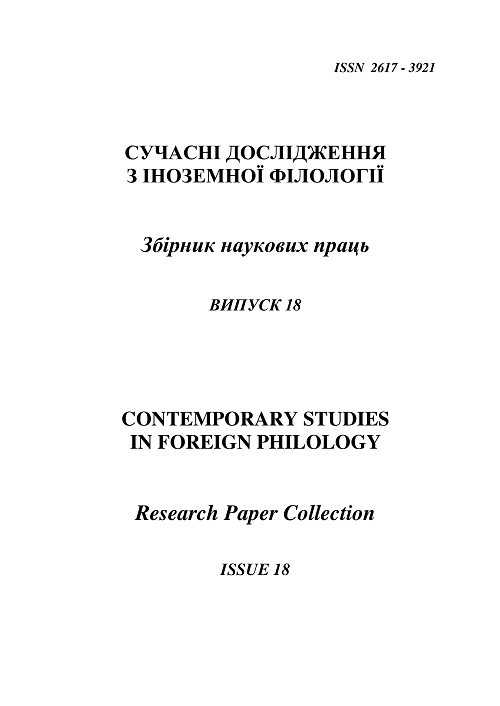Lernen an Hand der literarischen Texte
DOI:
https://doi.org/10.24144/2617-3921.2020.18.321-330Анотація
The purpose of this scientific article is to highlight the importance of using the text and working with it as a central component of the educational context of a foreign language, and particularly the importance of working with the text for the formation of language competencies. Literary text is considered as a methodological and didactic tool for learning a foreign language. The importance and necessity of using literary texts in the process of learning a foreign language is explained by a few factors. Literary text is, firstly, a source of linguistic and cultural information about the people whose language is being studied (history, culture, social order, economic and political characteristics, and secondly, a source of knowledge about functioning of the language system and its manifestations during the creation of a literary work.The necessity to use a literary text in foreign language classes is also explained by the fact that working with the text contributes to the formation of worldview, own opinion, helps to develop statements about various situations in a foreign language. Working with the text forms, develops and improves all language competencies, if the text is selected methodically correctly. The main criteria for selecting a text for a foreign language lesson are compliance with the level of knowledge and compliance with the learning objective at a particular stage. Each literary text is in fact an inexhaustible source of information, and it is the teacher whose main responsibility is to teach a student how to extract, analyze and be able to use this information for discussion. Work on any literary text must be thoroughly thought through and logically planned. At the initial stage of learning a foreign language, one of the best literary genres is a fairy tale, which involves imagery, abstraction and teaching. It is particularly interesting to elaborate on a fairy tale, the content of which carries information about the national-linguistic picture of the world. Based on the selected fairy tale, just as on any other literary text, a number of practical tasks are offered, which are recommended to be performed in foreign language classes before, during and after getting acquainted with the content of the text. This type of activity allows you to reveal the creative potential of students, encouraging them to think creatively and comprehend the hidden content. Therefore, the reading aspect, through which we learn both the language and culture of another people, should be given special attention in the educational process.
Keywords: foreign language classes, work with text, language competencies.
Посилання
Adamzik K. Textsorten und ihre Beschreibung. Textlinguistik. Einführungen. Tübingen: Narr, 2008. S. 145-176.
Barkowski H., Krumm H.-J. Fachlexikon Deutsch als Fremd- und Zweitsprache. Tübingen: Francke, 2010. 780 S.
Bimmel P. Lernerautonomie und Lernstrategien. München: Langenscheidt, 2000. 208 S.
Edelhoff Chr. Authentizität im Fremdsprachenunterricht. Authentische Texte im Deutschunterricht. Einführung und Unterrichtsmodelle. München: Hueber, 1995. S. 7-30.
Götz M. Schriftspracherwerb als grundschuldidaktisches Problem. Lese-Schreibschwache. Vorbeugen, Erkennen, Helfen. Lese-Schreibschwache. Vorbeugen, Erkennen, Helfen. Würzburg: edition bentheim, 2004. S.75-94.
Hallet W. Didaktische Kompetenzen. Lehr- und Lernprozesse erfolgreich gestalten. Stuttgart: Klett, 2006. 213 S.
Hufeisen B. Mehr Sprachen? – Plur Cur! Berichte aus Forschung und Praxis zu Gesamtsprachencurricula. Baltmannsweiler: Schneider Verlag Hohengehren, 2016. S. 130-141.
Hufeisen B. Förderung des DaF-Unterrichts durch Mehrsprachigkeitskonzepte. Förderung der deutschen Sprache weltweit Vorschläge, Ansätze und Konzepte. Berlin/Boston: de Gruyter, 2019. S. 337-350.
Hufeisen B., Thonhauser I. Authentische, didaktisierte und didaktische Texte – Überlegungen zur Textarbeit aus drei verschiedenen Perspektiven. Auf dem Weg zu einer Textsortendidaktik. Linguistische Analysen und text(sorten)didaktische Bausteine nicht nur für den fremdsprachlichen Deutschunterricht. Hildesheim, Zürich, New York: Olms, 2018. S. 149-164.
Hüllen W. Kleine Geschichte des Fremdsprachenunterrichts. Berlin: Schmidt, 2005. 254 S.
Krumm H.-J. Lehrwerke im Deutsch als Fremd- und Deutsch als Zweitsprache-Unterricht. Deutsch als Fremd- und Zweitsprache. Ein internationales Handbuch. Berlin, New York: Edition, 2010. S. 1215-1226.
Piepho H.-E. Leseimpuls und Textaufgabe. Textarbeit im Deutschunterricht. Fremdsprache Deutsch. Jg. 2. 2005. S. 4-9.
Riedner R. Authentizität in der Fremdsprachendidaktik – kritische Anmerkungen zu einem problematischen Konzept. Deutsch als Fremdsprache. 2018. Jg. 55. S. 34-43.
##submission.downloads##
Номер
Розділ
Ліцензія
Автори, які публікуються у цьому журналі, погоджуються з наступними умовами:
- Автори залишають за собою право на авторство своєї роботи та передають журналу право першої публікації цієї роботи на умовах ліцензії Creative Commons Attribution License, котра дозволяє іншим особам вільно розповсюджувати опубліковану роботу з обов'язковим посиланням на авторів оригінальної роботи та першу публікацію роботи у цьому журналі.
- Автори мають право укладати самостійні додаткові угоди щодо неексклюзивного розповсюдження роботи у тому вигляді, в якому вона була опублікована цим журналом (наприклад, розміщувати роботу в електронному сховищі установи або публікувати у складі монографії), за умови збереження посилання на першу публікацію роботи у цьому журналі.
- Політика журналу дозволяє і заохочує розміщення авторами в мережі Інтернет (наприклад, у сховищах установ або на особистих веб-сайтах) рукопису роботи, як до подання цього рукопису до редакції, так і під час його редакційного опрацювання, оскільки це сприяє виникненню продуктивної наукової дискусії та позитивно позначається на оперативності та динаміці цитування опублікованої роботи (див. The Effect of Open Access).

